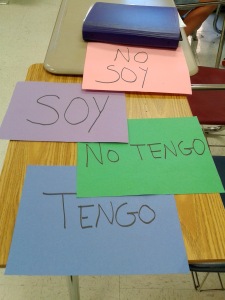In my classroom, I have an outside door:

Every once in awhile, when it’s a pretty day, I like to go outside for a short activity. I find that partner speaking activities work well outside. Today it was 65 degrees and sunny (I love Georgia weather!), so I printed a half-page handout with questions on one side and helpful phrases for answering on the back. We formed two lines with partners facing each other. Students took turns asking and answering questions, and I walked around to listen and give feedback. A two minute timer on my phone reminded us when to switch roles (asking/answering), and we also changed partners once or twice, in order to get more reps of the questions. At the end, we huddled up for a chat, or I called out the questions to the group, and everyone answered at once. It was a nice change of scenery, and it was much easier to switch partners without all the classroom furniture in the way!




